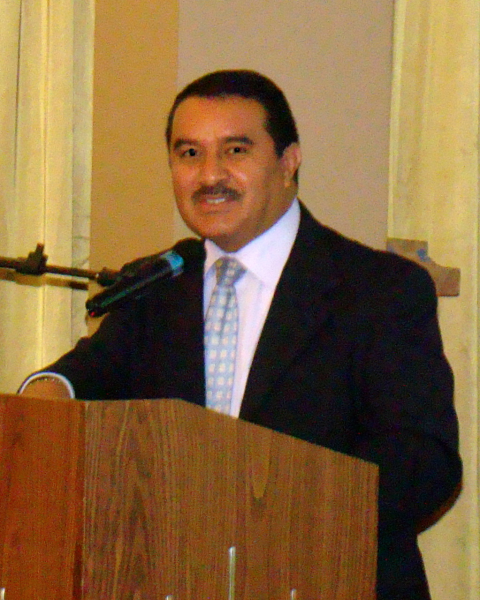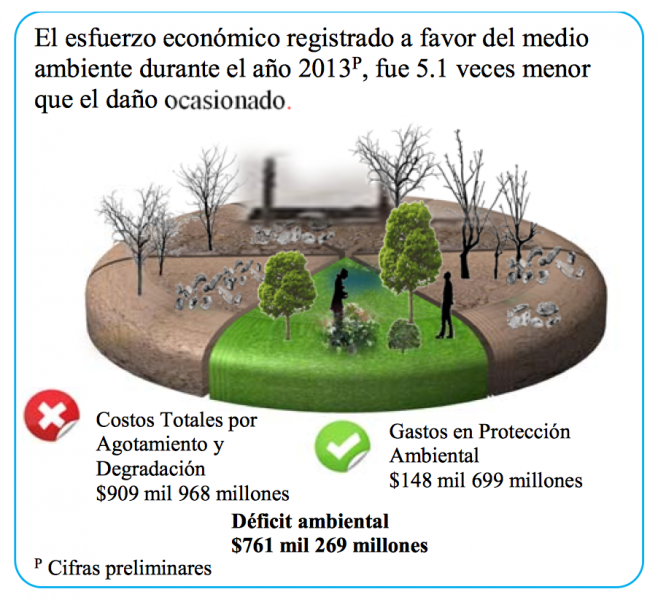Mexico’s National Institute of Statistics and Geography (INEGI) recently published preliminary environmental accounts for 2013, which show that the country's GDP growth is not as tied to environmental damage and the depletion of natural resources as in the past.
The accounts, which have been produced annually for over 20 years, provide information on the exhaustion of natural resources, environmental degradation and environmental protection expenditures. Since 1985, INEGI has calculated a yearly Green GDP aggregate.

Mexico’s Director of Satellite Accounts, Raúl Figueroa Díaz, spoke with WAVES about the results.
What information in the accounts has generated the most interest?
Mexico (INEGI) has been generating environmental accounts for more than 20 years that not only allow us to quantify in physical terms the status and quality of natural resources and environment (cubic meters of water, tons of emissions, etc.), but to estimate the economic value of the depletion and degradation of resources. It is noteworthy that few countries carry out economic assessment exercises of this type.
The information that has generated the most interest is environmental costs, which allow us to measure the impacts of economic activities on the environment. Also, they provide Environmental Protection Expenditures (EPE)—the monetary efforts that the society as a whole puts aside to compensate such damages, which is 1 percent of our GDP, which positions us even above some OECD (Organization for Economic Co-operation and Development) countries.
Another issue that is gathering particular interest is the decoupling (separation) between environmental damage and GDP growth. This implies that the dependence of the economy on the environment, either as a source of raw materials or a waste dump, is becoming smaller.
The results of the environmental accounts have also been an important input for the development of other national and international initiatives such as the national development plan, the environment sectoral programme, green growth and green economy indicators, mining indicators, among others.
Finally, the results of the environmental accounts are aligned with updates of the base year of Mexico’s System of National Accounts.

How often are the accounts updated?
Results are updated annually, according to a National Interest Information release calendar previously established by the Board of Governors of INEGI, under the framework of the National System of Statistical and Geographical Information (SNIEG, Spanish acronym). The 2014 results will be released this November.
What is the institutional arrangement for gathering and reporting data?
In 1989, the Mexican Government, the World Bank, the United Nations Statistics Division (UNSD) and INEGI developed the first case study in the world (using 1985 data) for the development of environmental accounts. Since then, with the support, at first from the General Law of Ecological Equilibrium and Environmental Protection (LGEEPA), and subsequently the SNIEG Act, tasked INEGI to integrate National Accounts (which include the Satellite Accounts) (Article 59).
Additionally, there are general collaboration agreements with different institutions, and if necessary special agreements are created for the development of specific projects, such as those with the National Polytechnic Institute (IPN) and the Institute for Economic Research (IIEc- UNAM).
The SNIEG Act also allows and encourages interaction between involved stakeholders through the creation of Specialized Technical Committees and Technical Working Groups, which exist for: water; climate change; emissions, waste and hazardous substances, basic geographic information; energy; land use, vegetation and forest resources; and cadaster and registry information.

Have you noticed any upward or downward trends since Mexico has been building accounts?
The Total Costs of Depletion and Environmental Degradation (CTADA) compared to national GDP has decreased year after year, from 8.5 percent in 2003 to 5.7 percent in 2013. This allows us to observe a positive trend towards decoupling between economy and in reducing negative externalities to the environment.
Note that the CTADA are comprised of costs associated to depletion (forest resources, groundwater, and hydrocarbons) and environmental degradation (solid waste, air emissions, wastewater and land degradation).
What has been the response, if any, from policymakers, and have the accounts influenced any changes in policy?
At the national level they have been very useful in strategic development plans and environmental public policy. Using the accounts to quantify the cost of environmental pollution and depletion of natural resources and indicators, such as the Ecological Net Domestic Product, are present in the statements of Article 15 of the General Law of Ecological Balance and Environmental Protection. In the National Development Plans from the last three administrations, “Green GDP” was considered as an indicator of sustainable development.
They have also been considered in the formulation of public policies related to mitigation and adaptation to climate change by highlighting the use of variables as the costs associated with depletion and environmental degradation. The publication, "Estimates of the Impact of Climate Change Report, from the System of Economic and Ecological Accounts of Mexico 2010-2100" provided decennial estimates of GDP and GNP using the structure of the Environmental Accounts and estimating the costs of climate change to determine the Ecological Net Domestic Product.
What lessons has Mexico learned doing NCA that could be useful to other LAC countries?
- It is important they are done consistently.
- That new methodologies and information sources for environmental accounting are constantly evolving.
- To develop technical notes and calculation reports of the process.
- To maintain constant communication with all the organizations (stakeholders) that provide information, as well as with the users of information to know what the needs and expectations are.
- To develop appropriate mechanisms to support the compilation of environmental accounts such as international cooperation agreements, which allow the transfer of knowledge and experience of countries that have already started or are in process of implementing this accounting system.
- Also to participate in professional development and workshops that encourage the development of national technical capacities to ensure their implementation and maintenance over time.
